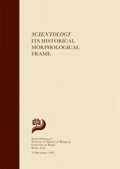1. In Christian culture the whole of the doctrines concerning the basic religious values takes on the name of theology, because everything is related to the knowledge of God and his Will. Here, the term and concept of Scientology substitutes for “theology.” Instead of being the study (-logy) of God (theo-), we have the study (-logy) of knowledge (sciento-). In both cases, though, the real aim of knowledge is the absolute; in fact this “knowledge” is absolute. Although it seems to require study and application, it is spiritual and transcends empiric knowledge of the physical universe, even though it is believed to be able to make an intervention in it.
The doctrinal content of Scientology is born out of the tendency to look inward, which can also be found in the Christian research of “God in yourself, ” which is typical of mystical insurgences. A proposition of the Church of Scientology—expressed in its constitutive act in California—is that: “The best proof of the existence of God is the God that man finds inside himself.” However, the explicit and implicit model of the Scientology inward search is the process of the Vedic religion, which started with the meditation on the Upanishad.
The Upanishad model is devised in the following way: the substance of the universe, Brahma, identifies itself with the substance of man, atman; so man can contact the universe through the acknowledgement of his own atman, without turning to the gods who, as in any polytheistic religion, are the universe itself in its various forms and aspects. In Scientology, in the place of the atman we find the thetan in the function of “immutable essence” which transcends any contingent form.
The notion of thetan is basic for the Scientology faith, as much as the notion of soul is for the Christian faith.
2. The notion of thetan is basic for the Scientology faith, as much as the notion of soul is for the Christian faith. But because of the need to distinguish the concept of thetan from that of the soul, Scientology created the new word, thetan, as more fitting for a new religion.
The new word answers to two opposing needs: 1) to achieve a complete renewal, free from any semantics; thus a non-existent word, without any meaning in any existing language; 2) the limiting of the arbitrary of the invention, so that the new word would not be without a meaning even if it didn’t have a meaning in the existing languages. In sum, it was wanted to give the new word a necessity which would overcome the contingency of artifice. The Greek letter theta, which by itself does not mean anything, was chosen. It is also the first letter of Theos (God) and of Thymos (soul) and has been chosen as the root for a word which phonically is similar to the Indian atman.
The morphological connection between atman and thetan, which we would objectively judge as due to the derivation of the second term from the first, is instead viewed by Scientology as an Indian anticipation of the Hubbardian concept; so that we find in the Scientology books: “The Eternal Indestructible Self (Atman) in the Upanishad is a precocious anticipation of the Scientological concept of thetan.”
3. Scientology follows the Upanishad model with the aim of looking inward to find a correct relationship between self and the universe: “Little by little, while the thetan progresses in the knowledge about himself, his ability to relate with the universal forces (dynamics) operating on the level of becoming (as opposed to the level of being, where the thetan becomes recognizable) increases.”
The Dynamics are eight and they are the urges toward survival of the individual as oneself; through sex and the family; the group (extending from the community to nationality); mankind; life forms (including animals and plants); the physical universe; the spiritual universe—symbolized by the letter Theta, as in the thetan, or spiritual being; and the Supreme Being.
4. From the relationship between the thetan and the eight dynamics, there are psychosomatic, ethical, parascientific and ritual consequences. In Scientology terms, the relationship is understood as the reduction of the chaos to the orderly reality constituted by the thetan. We could understand it all in historic-religious terms, finding the typical function of any religion in conferring a metahistorical value to the historical realities. Here, as elsewhere, the object is to overcome with the metahistorical “being” the chaotic historical “becoming”—history itself, seen as a personal history, national history, the history of mankind, natural history, supernatural history (the creation of the world, the action of the Creator, his intervention on the created). All these “histories” trap and destroy the individual who does not know how to orient himself (and orient them) because the thetan has lost awareness of himself. But when the thetan has reached his full awareness, everything is in order again, with these consequences:
Psychosomatic consequences: The thetan precipitates mental and physical health, giving the best possible direction to the activity of the body and the psyche.
Ethics: The thetan directs family relationships, along with social and generically human relationships.
Scientific: The thetan illuminates scientific and technological research in all fields. Apart from the technical and scientific production, it also favors artistic and literary production. The teacher Hubbard is exalted both as a writer and as a scientist, who was especially talented in seamanship, photography, music, mineralogy, agronomy and communication systems.
From this viewpoint, we can notice how the parallel with the Upanishad is brought to its extreme consequences: the Tantrism, the ultimate product of that religious evolution, promises powers which, related to that time and environment, we would define as “magic”; Scientology promises powers which we call artistic-literary or scientific or technological; but in both cases, one can speak about the mystical opening of the world to any intervention by the being who has discovered in himself the mystical ability to intervene.




























